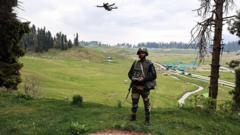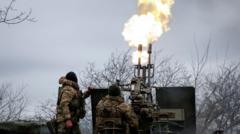Following airstrikes by India and retaliatory actions from Pakistan, both nations are confronted with a potential escalation of conflict, raising concerns over regional stability.
Rising Tensions: India and Pakistan on the Brink of Escalation

Rising Tensions: India and Pakistan on the Brink of Escalation
The conflict between India and Pakistan intensifies as airstrikes and military actions leave both nations on high alert.
The tension between India and Pakistan escalated dramatically following recent military actions and airstrikes. With India launching significant airstrikes on Pakistani-held Kashmir, reports indicate that the Pakistani military retaliated by downing at least two Indian aircraft. This chain of events has raised concerns over whether Pakistan may feel compelled to escalate its response with further attacks into Indian territory.
Amidst these rising tensions, Pakistan’s government has announced that it is contemplating all available options as regional analysts and diplomats express cautious optimism about averting a full-scale war. Pakistan's defense minister has indicated a willingness to support increased U.S. diplomatic efforts aimed at de-escalating the crisis, which could provide a potential path to reducing conflict.
The aftermath of India's airstrikes reportedly left over 20 individuals dead and numerous others injured in Pakistani territories, prompting outrage among local populations. On the Indian side of Kashmir, at least 10 casualties have been reported due to retaliatory shelling from Pakistan, escalating fears of a broader confrontation.
While India celebrated its “Operation Sindoor” as a success following a deadly terrorist attack in Kashmir, there are indications that the operation may have resulted in significant losses for Indian forces as well. Historical context showcases that while both nations have experienced periods of managed hostility, both sides are now navigating a precarious moment that could redefine their long-standing conflict.
In reflecting on historical hostilities, the challenge remains: will this latest round of conflict be managed, or is it the prelude to an even larger confrontation? As the situation unfolds, the international community watches closely, hoping for a resolution before the conflict spirals further out of control.
Amidst these rising tensions, Pakistan’s government has announced that it is contemplating all available options as regional analysts and diplomats express cautious optimism about averting a full-scale war. Pakistan's defense minister has indicated a willingness to support increased U.S. diplomatic efforts aimed at de-escalating the crisis, which could provide a potential path to reducing conflict.
The aftermath of India's airstrikes reportedly left over 20 individuals dead and numerous others injured in Pakistani territories, prompting outrage among local populations. On the Indian side of Kashmir, at least 10 casualties have been reported due to retaliatory shelling from Pakistan, escalating fears of a broader confrontation.
While India celebrated its “Operation Sindoor” as a success following a deadly terrorist attack in Kashmir, there are indications that the operation may have resulted in significant losses for Indian forces as well. Historical context showcases that while both nations have experienced periods of managed hostility, both sides are now navigating a precarious moment that could redefine their long-standing conflict.
In reflecting on historical hostilities, the challenge remains: will this latest round of conflict be managed, or is it the prelude to an even larger confrontation? As the situation unfolds, the international community watches closely, hoping for a resolution before the conflict spirals further out of control.





















